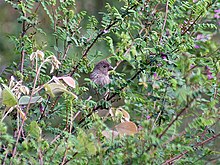Common rosefinch: Difference between revisions
No edit summary |
|||
| Line 29: | Line 29: | ||
==External links== |
==External links== |
||
*[http://www.acopiancenter.am/boa.asp?id=331 A Field Guide to Birds of Armenia: Common Rosefinch] |
|||
*[http://www.oiseaux.net/birds/photos/common.rosefinch.html Oiseaux] Photos |
*[http://www.oiseaux.net/birds/photos/common.rosefinch.html Oiseaux] Photos |
||
*[http://orientalbirdimages.org/search.php?action=searchresult&Bird_ID=1995 OBC] 39 photographs (see pulldown menu at page bottom) |
*[http://orientalbirdimages.org/search.php?action=searchresult&Bird_ID=1995 OBC] 39 photographs (see pulldown menu at page bottom) |
||
Revision as of 15:05, 24 November 2010
| Common Rosefinch | |
|---|---|

| |
| Scientific classification | |
| Kingdom: | |
| Phylum: | |
| Class: | |
| Order: | |
| Family: | |
| Genus: | |
| Species: | C. erythrinus
|
| Binomial name | |
| Carpodacus erythrinus (Pallas, 1770)
| |
| Synonyms | |
|
Erythrina erythrina | |


The Common Rosefinch (Carpodacus erythrinus) is the most widespread and common rosefinch of Europe, where it has spread westward from Asia in recent decades: it has even been recorded breeding in England once. Common Rosefinches breed from the Danube valley, Sweden, and Siberia to the Bering Sea; the Caucasus, northern Iran and Afghanistan, Pakistan and the western Himalaya, Tibet and China; to Japan between latitudes 25° and 68°. In winter they are found from southern Iran to south-east China, India, Burma, and Indochina.
The mature male has brilliant rosy-carmine head, breast and rump; heavy bill; dark brown wings with two indistinct bars, and a white belly. Females and young males are dull-colored with yellowish-brown above, brighter on the rump and grayer on head; buff below.
They are found in summer in thickets, woodland and forest edges near rivers and in winter in gardens and orchards, wetlands and locally in dry oak woods.
The nest is placed low in a bush and the five eggs are dark blue with coarse dark brown spots.
References
- Template:IUCN2006 Database entry includes justification for why this species is of least concern
External links
- A Field Guide to Birds of Armenia: Common Rosefinch
- Oiseaux Photos
- OBC 39 photographs (see pulldown menu at page bottom)
- Avibase

